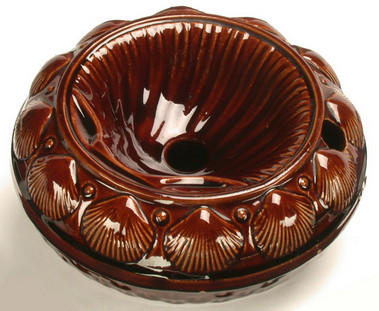
Spitting is the most effective way of getting rid of excess sputum, or tobacco juice, from your nose and throat. For both health and social reasons spitting on the floor in public places is unacceptable in this, and many other, countries. Used from the Victorian period onwards, the spittoon was placed near the fire in homes and public houses. It was used to collect the tobacco juice or sputum from people who needed to spit it out. Provided the person had a good aim, the liquid would run down the sides of the indented cover, and slide into the bowl.
Spittoons became a serious heath hazard for those who had the task of cleaning them out, as there was a likelihood of tuberculosis being present in the spittle. Tuberculosis (TB), or consumption was a common disease during the Victorian period.
This spittoon is made out of clay. The bowl has a pattern of seashells created by impressing the damp clay against a mould with the sea shell pattern already in place.
The wall of the spittoon expands out from the base up to the rim, and then it curves down half way inside the bowl, providing a cover. In the centre of the cover is a hole leading into the hollow bowl.

Diameter:19cm
During the 19th century health practitioners and doctors knew little about the causes of the diseases prevalent at the time, including cholera, tuberculosis, smallpox and diphtheria. People became ill, but did not understand why they were ill, and the symptoms of many diseases can appear to be very similar. Doctors treated the symptoms of disease, not the causes.
There was little awareness of the fact that germs thrive and multiply in dirty places. During the 19th century people washed very infrequently, They shared dirty cups and dishes. When someone fell ill, the sickroom was kept dark and stuffy, as fresh air and sunlight was seen as counterproductive to recovery. A whole family might get TB by infecting each other without realising how this was happening.
In 1882 Robert Koch discovered the tubercle bacillus, and the true nature of the disease could be understood. Robert Koch was born in Germany in 1843 and combined a career as a surgeon with research into the cause of disease. He began to look at various strains of bacteria under a microscope, note similarities and differences, and attempt to understand how they grew and behaved. Koch evolved a way of separating a mixture of bacteria, and began to identify the bacteria responsible for a variety of diseases.
He published Koch's Postules, providing a methodology of how to prove that an organism was the cause of a particular disease. He isolated and grew the tubercle bacillus, believing this to be the cause of all forms of TB. In 1905 he was awarded the Nobel Prize for Physiology for investigations and discoveries in relation to TB.
Tubercles are fine granules, barely visible to the human eye. They grow in every organ in the body, including the lungs and brain. As they grow they damage the host organ. TB is a highly contagious disease. The tubercle bacteria can be carried in milk and other foods, and in the saliva of someone already infected with TB. The bacteria also live in the air, and when someone with TB coughs, the bacteria could be transferred to another person.
Spitting became a criminal offence because the bacteria survived in the spittle. Spittoons were eventually seen as heath hazards in themselves, as the person responsible for cleaning them could catch TB.
Early cures for TB had failed. They included vigorous horse riding, smoking cow dung, and eating mice boiled in salt and oil. A natural cure for TB is direct sunlight. By the end of the 1950s there was a vaccine developed that prevented people from catching TB. The vaccine is called BCG and TB was almost eliminated - although it is now on the increase.

Diameter:19cm

Spitting is the most effective way of getting rid of excess sputum, or tobacco juice, from your nose and throat. For both health and social reasons spitting on the floor in public places is unacceptable in this, and many other, countries. Used from the Victorian period onwards, the spittoon was placed near the fire in homes and public houses. It was used to collect the tobacco juice or sputum from people who needed to spit it out. Provided the person had a good aim, the liquid would run down the sides of the indented cover, and slide into the bowl.
Spittoons became a serious heath hazard for those who had the task of cleaning them out, as there was a likelihood of tuberculosis being present in the spittle. Tuberculosis (TB), or consumption was a common disease during the Victorian period.
This spittoon is made out of clay. The bowl has a pattern of seashells created by impressing the damp clay against a mould with the sea shell pattern already in place.
The wall of the spittoon expands out from the base up to the rim, and then it curves down half way inside the bowl, providing a cover. In the centre of the cover is a hole leading into the hollow bowl.